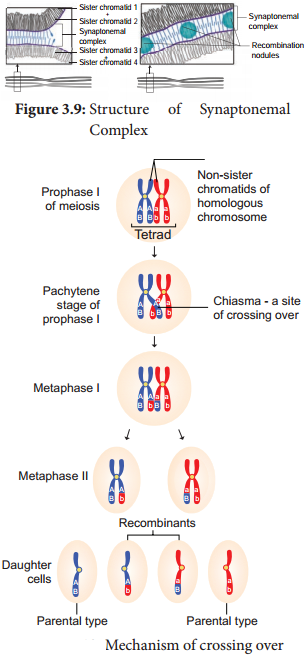Learninsta presents the core concepts of Biology with high-quality research papers and topical review articles.
Crossing Over, Recombination and Gene Mapping
Crossing over is a biological process that produces new combination of genes by interchanging the corresponding segments between non-sister chromatids of homologous pair of chromosomes. The term ‘crossing over’ was coined by Morgan (1912).
It takes place during pachytene stage of prophase I of meiosis. Usually crossing over occurs in germinal cells during gametogenesis. It is called meiotic or germinal crossing over. It has universal occurrence and has great significance. Rarely, crossing over occurs in somatic cells during mitosis. It is called somatic or mitotic crossing over.
Mechanism of Crossing Over
Crossing over is a precise process that includes stages like synapsis, tetrad formation, cross over and terminalization.
(i) Synapsis
Intimate pairing between two homologous chromosomes is initiated during zygotene stage of prophase I of meiosis I. Homologous chromosomes are aligned side by side resulting in a pair of homologous chromosomes called bivalents. This pairing phenomenon is called synapsis or syndesis. It is of three types,
- Procentric synapsis: Pairing starts from middle of the chromosome.
- Proterminal synapsis: Pairing starts from the telomeres.
- Random synapsis: Pairing may start from anywhere.
(ii) Tetrad Formation
Each homologous chromosome of a bivalent begin to form two identical sister chromatids, which remain held together by a centromere. At this stage each bivalent has four chromatids. Ths stage is called tetrad stage.
(iii) Cross Over
After tetrad formation, crossing over occurs in pachytene stage. The non-sister chromatids of homologous pair make a contact at one or more points. These points of contact between nonsister chromatids of homologous chromosomes are called Chiasmata (singular-Chiasma).
At chiasma, cross-shaped or X-shaped structures are formed, where breaking and rejoining of two chromatids occur. This results in reciprocal exchange of equal and corresponding segments

(iv) Terminalisation
After crossing over, chiasma starts to move towards the terminal end of chromatids. This is known as terminalisation. As a result, complete separation of homologous chromosomes occurs. (Figure 3.10)
Importance of Crossing Over
Crossing over occurs in all organisms like bacteria, yeast, fungi, higher plants and animals. Its importance is
Exchange of segments leads to new gene combinations which plays an important role in evolution. Studies of crossing over reveal that genes are arranged linearly on the chromosomes. Genetic maps are made based on the frequency of crossing over. Crossing over helps to understand the nature and mechanism of gene action.
If a useful new combination is formed it can be used in plant breeding.
Recombination
Crossing over results in the formation of new combination of characters in an organism called recombinants. In this, segments of DNA are broken and recombined to produce new combinations of alleles. This process is called Recombination.
Calculation of Recombination Frequency (RF)
The percentage of recombinant progeny in a cross is called recombination frequency. The recombination frequency (cross over frequency) (RF) is calculated by using the following formula. The data is obtained from alleles in coupling confiuration.
Genetic Mapping
Genes are present in a linear order along the chromosome. They are present in a specific location called locus (plural: loci). The diagrammatic representation of position of genes and related distances between the adjacent genes is called genetic mapping.
It is directly proportional to the frequency of recombination between them. It is also called as linkage map. The concept of gene mapping was first developed by Morgan’s student Alfred H Sturtevant in 1913.
It provides clues about where the genes lies on that chromosome.
Map distance
The unit of distance in a genetic map is called a map unit (m.u). One map unit is equivalent to one percent of crossing over (Figure 4.). One map unit is also called a centimorgan (cM) in honour of T.H. Morgan. 100 centimorgan is equal to one Morgan (M).
For example: A distance between A and B genes is estimated to be 3.5 map units. It is equal to 3.5 centimorgans or 3.5 % or 0.035 recombination frequency between the genes.

Uses of genetic mapping
- It is used to determine gene order, identify the locus of a gene and calculate the distances between genes.
- They are useful in predicting results of dihybrid and trihybrid crosses.
- It allows the geneticists to understand the overall genetic complexity of particular organism.